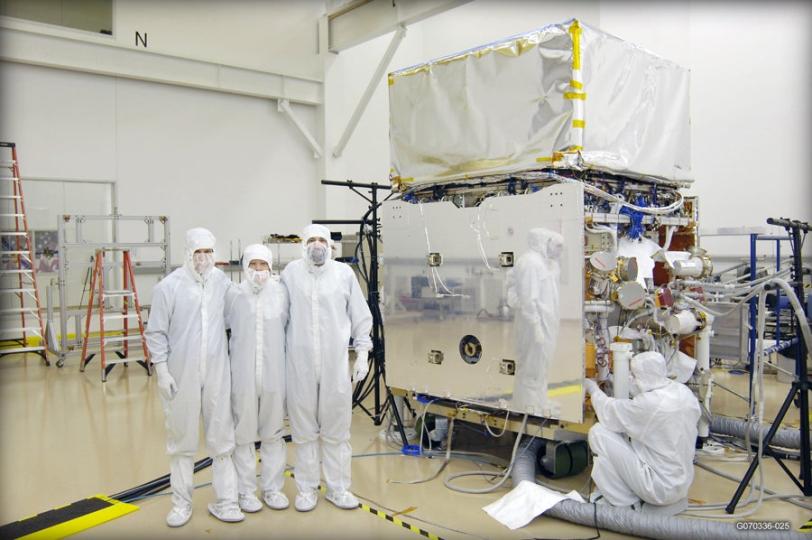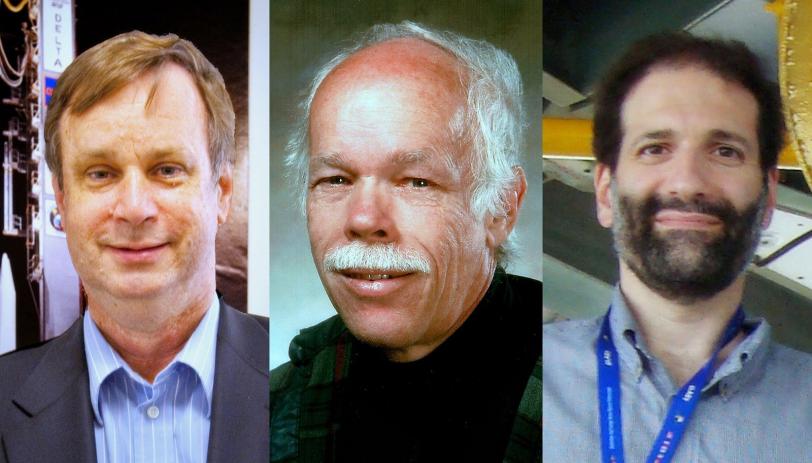Perspectives on 10 Years of Discovery With Fermi
By capturing the most energetic light in the sky, the spacecraft continues to teach us about the mysteries of the universe.
By William Atwood, Peter Michelson and Steven Ritz
Ten years ago on this day, the Fermi Gamma-Ray Space Telescope (then called GLAST) was launched into space, beginning its mission to explore the most energetic light in the universe and the powerful cosmic processes that produce it.
On board the spacecraft are two scientific instruments. The Large Area Telescope (LAT) is the main instrument, and it creates detailed maps of gamma-ray sources in the sky. The LAT was assembled at the Department of Energy’s SLAC National Accelerator Laboratory from parts fabricated at institutes around the world. SLAC also hosts the science operations center that processes the LAT data. The second instrument is the Gamma-ray Burst Monitor (GBM), which detects gamma-ray flashes from the brightest explosions known to occur in the universe.
In this article, three Fermi scientists reflect on the past decade of gamma-ray explorations with the observatory. William Atwood, adjunct professor of physics at the University of California, Santa Cruz, invented and developed the concept for the LAT and was instrumental in demonstrating its performance via detailed simulations. Peter Michelson, professor of physics at Stanford University, is the principal investigator of the LAT and the spokesperson for the international LAT collaboration. Steven Ritz, professor of physics at UC Santa Cruz, was the project scientist at NASA during the development of the mission through most of the first year of science operations, as well as deputy principal investigator for the LAT.

Reaching 10 years of Fermi operations is a wonderful achievement, made possible by thousands of people around the world, and it provides an opportunity for reflection. Every person who has worked on the mission has a unique perspective – here are some of ours.
Mostly, even after all this time, we continue to be amazed at how a large and distributed team that brings together people from diverse backgrounds works so effectively across the mission. Of course, there were also many challenges along the way, and not everything worked smoothly, but we admire the brilliance and dedication of the people who contributed to the mission, both before and after launch, including the whole mission team and the many users of the public Fermi data.
We’ve found it difficult to pick our favorite science results so far, as Fermi has enabled advances in so many areas. Metrics of scientific productivity, such as the number of papers (more than 3,000 since launch), are impressive, as are the sheer number and variety of gamma-ray sources whose study Fermi has transformed.
These sources include Earth's atmosphere (gamma-ray flashes from lightning), the sun, stellar novae, as well as powerful pulsars and other remnants of stellar explosions, which turn out to be powerful galactic particle accelerators. They also include emissions with surprising structures (most notably the Milky Way’s Fermi bubbles); supermassive black hole systems across the universe, whose emissions are territory we are still prospecting for treasure; and the gamma-ray glow of the universe that tells us about the history of star formation. Finally, there are all the other types of new physics Fermi is tremendously capable of studying, including the elusive identity of dark matter.
We have especially enjoyed the unanticipated, transformational opportunities enabled by the synergy between Fermi and other types of facilities, exemplified by the recent spectacular observations of a neutron star merger by Fermi in gamma rays and by LIGO/Virgo in gravitational waves.
Another example of this synergy is the NANOGrav endeavor to discover and monitor millisecond pulsars to detect gravitational waves, using Fermi data to identify the most promising places in the sky to search for them. In addition, discoveries of new dark-matter-rich regions of the sky by optical surveys, such as the Sloan Digital Sky Survey, Dark Energy Survey and the future Large Synoptic Survey Telescope, greatly amplify Fermi’s sensitivity to potential dark matter signals.
There is much more to do, of course. Further surprises and delightful discoveries may be just around the corner. For now, we’d like to take this opportunity to express our gratitude and to celebrate our collective good fortune. Happy birthday, Fermi! Congrats all around.
For more information on Fermi activities at SLAC, please visit the website of the Kavli Institute for Particle Astrophysics and Cosmology (KIPAC), a joint institute of SLAC and Stanford.
Contact
For questions or comments, contact the SLAC Office of Communications at communications@slac.stanford.edu.
SLAC is a multi-program laboratory exploring frontier questions in photon science, astrophysics, particle physics and accelerator research. Located in Menlo Park, Calif., SLAC is operated by Stanford University for the U.S. Department of Energy's Office of Science.
SLAC National Accelerator Laboratory is supported by the Office of Science of the U.S. Department of Energy. The Office of Science is the single largest supporter of basic research in the physical sciences in the United States, and is working to address some of the most pressing challenges of our time. For more information, please visit science.energy.gov.






